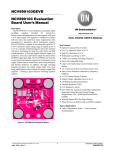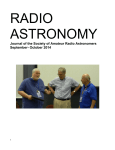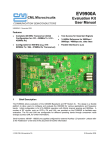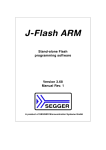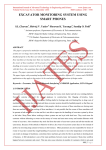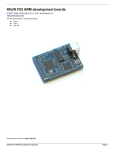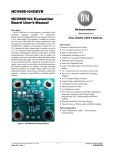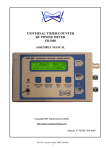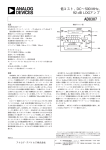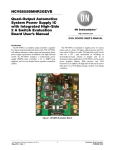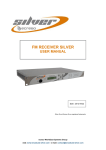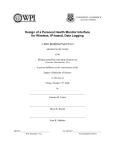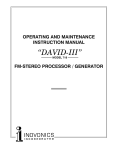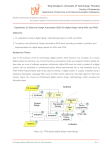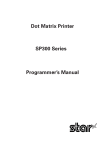Download NimbleSig III - Part I
Transcript
Thomas M. Alldread, VA7TA 7056 Railway Ave, Courtenay, BC V9J 1N4, CANADA; [email protected] NimbleSig III —Part 1 Build this dual output DDS RF generator and low-level RF power meter. This article describes the design and construction details for a stable, frequency agile, dual output, direct digital synthesizer (DDS) based RF signal generator module with a built in RF level meter. This module is intended to be used as a building block to provide the signal source and RF level measurement functions for many possible applications such as signal generators, swept frequency spectrum displays, receivers, transmitters and RF modems. It could provide both local oscillator signals for a dual conversion receiver or a pair of frequency locked signals for applications that require a quadrature phase offset local oscillator signal pair. The signal outputs can be described as frequency agile as they can be altered very quickly by command without any settling time requirement. The output frequencies can be independently set with 1 Hz resolution anywhere within the 100 kHz to 200 MHz range. The firmware provides an ASCII command line type interface, which enables control directly from a PC equipped with suitable serial port interface. Any conventional terminal program that supports 115,200 Baud (such as HyperTerminal) is all that is needed for the PC software to establish keyboard control of the dual DDS and signal level meter. When used as a building block for more complex applications control could be provided by any dedicated host microcontroller that has a UART peripheral capable of 115 KBaud and that is programmed to send the necessary commands to the NimbleSig module. During the past decade and a half I have been following the development of DDS technology and have designed and built about a dozen DDS generators. My first DDS generator had a relatively low clock rate of 50 MHz, which limited the maximum output frequency to about 20 MHz. I built it, along with an analog to digital converter (ADC), on a wire-wrapped ISA card that Reprinted with permission © ARRL filled a whole slot in my then state of the art 486 based PC. I controlled the DDS/ADC chips directly from the ISA computer bus with an application I dubbed “PanaBand,” which was written in the PASCAL language. Figure 1 is an example of the PanaBand full screen, VGA, color graphics display (considered high resolution in the early 1990s) that shows the IF output frequency spectrum from my HF transceiver. In addition to the frequency spectrum display PanaBand also provided GUI style mouse and point and click control of my transceiver via the serial port interface. The ability to view the frequency and strength of all the signals on the selected HF band with digital display accuracy and to also be able to tune to any one of them with just a “click of the mouse” seemed pretty wonderful in the early 1990s. Although my old PanaBand project will not be described here it is an example of what can be done with DDS technology when placed under computer control. The seemingly open-ended realm of possible applications associated with computer controlled DDS signal sources hooked me on further experimentation with this technology. My first version of this series of DDS signal source designs only provided a single output up to 160 MHz. It also provided AM/ FM modes and had a built in RF level meter. It used a 32 bit, 50 MHz ARM microcontroller with 64 KB of program memory space. To my very pleasant surprise, that project won second place in the Luminary Micro Inc sponsored “Design Stellaris 2006” international design competition, which was hosted by Circuit Cellar Magazine.1 NimbleSig III (NS3), described here, is my most recent DDS module design. It is relatively enhanced in that it provides two independent RF signal outputs with 1 Hz frequency step resolution up to 200 MHz. Either generator output can be AM/FM modulated at specified modulation indexes at rates from 1 Hz to 20 kHz. Alternately each RF generator can be simultaneously set to the same frequency to provide a pair of signals with accurate relative phase offsets. These offsets can be changed in very fine steps across the full 360° range. The built in RF power meter can measure levels with typical 1 dB accuracy from –50 to +10 dBm from just above the audio spectrum to about 500 MHz. NS3 uses a relatively recent DDS chip from Analog Devices Incorporated (ADI), which is clocked at 500 MHz. The 50 MHz, ARM7 NXP (formally Philips) controller used here has 512 KB of program memory space. This large instruction code space provides room for many enhancements to the firmware as only about 20% of the program memory space is currently used. Also new in this version is a 64 KB EEPROM, which is provided for non-volatile (NV) storage of internal initialization and calibration data. A 1 Notes appear on page 20. QEX – January/February 2009 3 Figure 1 — A Kenwood TS-850S transceiver IF spectrum display, based on early 1990s DDS technology. Figure 2 — The NimbleSig III block diagram illustrates the main sections of the circuit. 4 QEX – January/February 2009 Reprinted with permission © ARRL 16 KB block of this NV memory space is allocated for storing external host controller application data such as initialization values and frequency channel information. As shown in the lead photo, modern surface mount technology makes it possible to fit all the functionality and power of NimbleSig III into a very small (2 × 3 × 0.5 inch) package. Hardware Block and Level Diagram As shown in the Figure 2 block diagram, the reference clock for the MPU is provided by the internal 25 MHz, FOX 924, temperature-controlled crystal oscillator (TCXO) IC, which by optional default also provides the reference clock for the DDS. Both the DDS and MPU have internal phase lock loops that are programmed to multiply the clock reference input to the actual internal clock frequency, which, as mentioned in the introduction, is 50 MHz for the MPU and 500 MHz for the DDS. At room temperature the TCXO provides good enough frequency stability for many DDS applications. Using my relatively stable oven-controlled crystal oscillator (OCXO) referenced frequency counter, I have observed a day-to-day variation of less than 10 Hz when operating continuously at 100 MHz within a room-temperature controlled environment. Although the TCXO provides quite a respectable degree of stability it may not be sufficiently stable for applications that are critically frequency dependent or where the DDS cannot be left powered up for a long enough lead time to stabilize. Also, the DDS internal PLL, which in the case of the TCXO operation is set to multiply the reference clock frequency by 20, has the disadvantage of significantly increasing the phase noise. The DDS data sheet indicates a phase noise improvement of about 20 dB can be obtained by driving the clock input directly with a 500 MHz, low phase noise reference signal. Although I believe the TCXO/PLL combination is more than adequate for most applications much better phase noise performance should be possible if an external, low sideband noise, high overtone crystal oscillator (such as the Butler type) is used to drive a suitable multiplier to obtain a relatively quiet 500 MHz, 1 mW clock source. As shown in the upper left of Figure 2, an external clock signal may be optionally injected for the DDS frequency reference. The maximum drive amplitude is 1.4 V p-p into a 50 Ω load, which, considering a sine wave source, works out to about 5 mW or +7 dBm. The DDS specification states the injection level should be in the range of –5 Reprinted with permission © ARRL to +3 dBm (2 mW). The external input is directly terminated in 50 Ω and the clock is subsequently capacitive coupled to the DDS input, which floats on an internally generated dc bias. The ADI AD9958 IC has a pair of internal DDS engines, which use the clock signal as a reference to generate sine wave output signals on frequencies specified by data stored in the associated internal registers. The AD9958 is described in detail within the manufacturer’s data sheet.2 A great deal of information on the theory of DDS signal generation, including an Amateur Radio related project (AN557) can be found within Analog Devices’ library of DDS application notes.3 The DDS receives data and control signals from the MPU. The register data for setting the operating mode, frequency, phase and amplitude is sent serially via a high speed, 25 Mb/S, serial peripheral interface (SPI) bus. There are 3 control registers containing, in total, 6 bytes of data common to both DDS engines. In addition data is stored for each individual engine by 21 dedicated registers containing 82 bytes of channel specific information that includes frequency, amplitude and relative phase offset values. The SPI bus consists of four lines, namely “master input/slave output”(MISO) data, “master output/slave input”(MOSI) data, “serial clock”(SCLK) and “slave select”(SS). The MPU acts as the master and the DDS the slave. Details of the general operation of the SPI bus can be found on the Internet (see Note 4) and more specific information on the SPI format used for this application can be found within the DDS data sheet (see Note 2) and the MPU users manual.4, 5 There are nine additional control lines connecting the DDS and MPU that have various functions including chip select, DDS reset, DDS power control, register data update strobe and modulation step selection. The two RF outputs from the DDS, which contain both the desired output signals and the undesired images, are fed into seven pole, elliptic design type, low pass filters that strip off the images and any other out of band signals. These image regions, which extend from 300 MHz to 750 MHz and beyond, are attenuated by a minimum of 50 dB by the filters. The RF output levels are set to –10 dBm with frequency dependent amplitude calibration data that is stored within the EEPROM by the calibration subroutines. This data is sent to the DDS by the MPU each time a new frequency command is implemented. The output levels may be reduced by command in 0.1 dB steps to –20 dBm. It is also possible to bypass the calibration and operate at unleveled, full output, which is about –4 dBm mid spectrum. The RF level detector is designed around the popular, broadband AD8307 logarithmic response power detector IC from ADI. It has a bandwidth specification of dc to 500 MHz. The variable dc output from the detector is connected to one of the 10 bit analog-todigital converter inputs of the MPU. The RF detector IC has a significant response roll off between HF and UHF. Calibration data to compensate for this frequency roll off along with correction data for the device dependent logarithmic response variations is stored within the EEPROM during calibration. If the approximate frequency (specified in units of MHz) is supplied with the power measurement command, the level reading is adjusted for the frequency specified. Also during calibration, data from a curve fitting algorithm that matches the dynamic range response of the specific logarithmic detector IC is also saved in EEPROM. As shown in the block diagram the EEPROM data is conveyed to and from the MPU via an Inter-Integrated Circuit (I2C – for “I squared C”) bus. Details on the general operation of the I2C bus can also be found on the Internet.6 More specific information on the protocol for this application can be found in Microchip’s 24LC512 EEPROM data sheet.7 A UART peripheral within the MPU provides the 115,200 Baud, ASCII serial data communications link to the outside world. The data on the receive data (RXD) and transmit data (TXD) lines is in the positive 3.3 V, unipolar format typically found on 3.3 V microcontroller I/O pins. This simple logic level interface was selected as it offers both direct compatibility to a host controller microprocessor as well as indirect compatibility to either USB or legacy RS-232 serial port PC interfaces. Although this interface requires either an RS-232C level conversion or USB protocol conversion device to interface to a standard personal computer it was chosen as it provides the most universal fit for all perceived applications. The RXD and TXD MPU pins are protected from induced transients or other abnormal line conditions with 1K resistors. Two LEDs are provided to indicate status of the MPU. A red LED, designated RST, illuminates when the MPU reset line is pulled low to force the MPU to the reset state. A green LED, designated HEART, flashes at 72 PPM to indicate the firmware is executing. These indicators are not important to the normal operation of the module but can save a lot of time during programming, troubleshooting and debugging by indicating rather vague operational status “at a glance”. Six additional I/O lines make up the “Joint Test Action Group” (JTAG) bus, QEX – January/February 2009 5 Figure 3 — Section 1 of the NimbleSig III schematic diagram. 6 QEX – January/February 2009 Reprinted with permission © ARRL which is used for programming and debugging the software. These lines terminate on a SIP connector that provides connection to the software development system for programming and debugging. The LPC2138 MPU used here is a variant of ARM Incorporated’s ARM7 family manufactured by NXP (previously Philips) Semiconductors. The ARM 7 family of 32 bit MPUs are relatively powerful processors in comparison to the 8 bit microcontrollers more commonly seen in amateur radio projects. The ARM 7 is clocked roughly 10 times faster, processes 4 bytes at a time and in this case has more than 10 times the program memory space normally found in 8 bit MPU chips. One of the primary reasons for the use of an ARM processor is that it is well supported by software development tools that provide 64-bit arithmetic to calculate the DDS 32-bit frequency tuning words on the fly, which for this application, eliminates rounding error. The extra MPU power and memory space also provides the foundation for a plain text, command line style, man/machine interface. There is an abundance of storage room for help pages, register dump tables and calibration routines. The firmware has commands that provide the user full access to read or write to any of the DDS registers. The user is also given the power to change the DDS initialization values without the need to reprogram the MPU (The user may revert back to the original default parameters for recovery if needed). A very important consideration for the use of the LPC2138 MPU is that there are good quality and affordable integrated development environment (IDE) software tools available to write and maintain the software for this family of ARM processors. Rowely Associates’ Crossworks for ARM, which uses the well proven GNU GCC C compiler, was used to develop the NS3 firmware. Rowely Associates offer a non-commercial, hobbyist/student level license for this fully functional (not crippled or limited), professional quality, well supported IDE package at a much reduced price that is within reach of most serious radio amateur equipment builders.8 Considering all the advantages of the ARM processor the additional cost of just a few dollars over a more common 8 bit processor chip seems, in the author’s opinion, well justified. The two, dual output voltage power regulators shown in Figure 2 play a very important role in this design. Experience has proven that noise on the power rails is a major problem for DDS generators. If digital noise gets superimposed on the analog voltage bus to the DDS, noise sidebands of sigReprinted with permission © ARRL nificant level can appear across the spectrum. Also any noise on the TCXO power causes FM sidebands to appear. The most effective means for obtaining clean power for a DDS generator is by isolating the analog/digital buses from each other with dedicated voltage regulators. Fortunately, semiconductor manufacturers have introduced low cost, dual output voltage regulators in small packages that serve this need nicely. Separate voltage supply rails with dedicated regulators are provided here for the 3.3 V digital devices, 3.3 V TCXO supply, 1.8 V DDS digital supply and 1.8 V DDS analog supply. Power for the regulators is supplied from an external, regulated +5 V dc supply. The +5 V source passes through a low forward voltage drop, reverse polarity protection diode prior to distribution to the regulator inputs. Circuit Description The first schematic sheet shown in Figure 3 shows the details of the AD9958 DDS and analog power regulator circuitry. The various ground and power bus designators are shown at the lower left of the page. As shown there are four separate ground planes, namely, analog ground, digital ground, filter 0 ground and filter 1 ground. These ground planes are isolated from each other by PC board design. This design approach helps prevent the coupling of digital noise into the analog circuitry and crosstalk between the generator outputs that could otherwise be caused by noise voltage gradients on a relatively simplistic, single ground plane. The +5 V dc power input (center – left) is first routed through a Schottky diode that provides reverse polarity protection with only about a 0.4 V forward voltage drop. The diode output of 4.7 V supplies the RF Detector and the regulator inputs. The LP2966 dual output voltage regulators are of the ultra low voltage drop-out type. With the provided 1.3 V headroom, these devices have sufficient control margin to provide well regulated 3.3 V outputs. The 4.7 V power bus is bypassed with a 0.1 µF bypass capacitor (C27) to guard against possible RF noise superimposed on the 5 V power source. The power passes through a 1 Ω resistor (R5) that provides a small amount of low frequency isolation between the analog and digital grounds. This resistor also provides a convenient point to check the analog regulator input current. The load side of R5 feeds an RF bead that provides an impedance to RF current flow between the analog and digital grounds. C30, a tantalum input filter capacitor, provides a low impedance bypass of the analog regulator IC input to analog ground. As shown, the 1.8 V and 3.3 V regulator outputs are bypassed by two additional tantalum electrolytic capacitors (C31, C32). As the 3.3 V output only powers the TCXO, it operates with a light load of approximately 5 mA. In contrast the 1.8 V output feeds the DDS analog bus, which is a relatively heavy load of around 100 mA. The functions of the common components connected to the AD9958 DDS are described in Table 3, “Pin configuration and Function Descriptions” within the device datasheet given at the reference of Note 2. The 16 connections between the DDS and the MPU are shown entering a bus that reappears on sheet 2. Balanced lines on the PC board connect the push-pull RF outputs from the DDS to the associated transformer-coupled low pass filters. These balanced lines help prevent crosstalk between generator outputs. The transformer coupling isolates the filter grounds and provides efficient push-pull coupling of RF from the DDS outputs to the filter inputs. Power for the DDS DAC outputs is injected into the primary center taps of the transformers. Resistors R1, R2, R3 and R4 moderate the out of band impedance extremes presented to the DDS outputs, which if not moderated would cause excessive intermodulation distortion from image products. Capacitors C9 and C10 are RF bypasses for the center tap power injection points. A detailed description of the low pass filter design is given below. Figure 4 is the schematic for the MPU, TCXO, EEPROM, digital power regulator and RF detector circuitry. The 3.3 V and 1.8 V digital power is supplied from the dual digital power regulator U4. R9 provides a small amount of power decoupling from the 4.7 V bus and also provides a convenient test point for measurement of the input current to the regulator. Tantalum electrolytic capacitors C42, C43 and C44 ensure regulator stability. The 1.8 V output load is 60 to 80 mA. The 3.3 V output load that supplies the MPU, EEPROM and RF level detector is estimated to be less than 50 mA. As shown in the upper left of the diagram 3.3 V digital power is injected into pins 23, 43, 49 and 51 of the MPU. RFB2 and C41 provide decoupled injection of this power to the analog ADC reference voltage pin 7. R10 and R11 are current limiting resistors for the indicator LEDs. R15, 18, 19, 22, 23, 24, 26, 25 and R18, 19, 20 are logic pull-up and pull-down resistors respectively. C51 couples the 3.3 V p-p, 25 MHz square wave reference clock from the TCXO output to the XTAL1 clock injection pin of the MPU. R16 and 17 form a voltage divider to drop the amplitude to 1.4 V p-p for injection into the DDS. Note that if the external reference clock option is desired, R16 is omitted and R17 is changed to 51 W for QEX – January/February 2009 7 Figure 4 — Section 2 of the NimbleSig III schematic diagram. 8 QEX – January/February 2009 Reprinted with permission © ARRL terminating the external clock signal source. The external signal connection point is the high end of R17. R12 and R13 form a voltage divider to drop the 3.3 V logic level output from the MPU GPIO P30.0 pin to match the 1.8 V logic level of the DDS clock mode select input. The TXD and RXD pads provide connection points for the ASCII data communications connection to the host computer. R7 and 8 protect the MPU RXD, TXD internal interface circuitry from direct exposure to outside connection, extraneous voltages and/ or shorts to ground. The power to the 64KByte EEPROM, U3 is bypassed by C40. The power to the RF level detector U5 is decoupled by ferrite bead RFB3 and bypassed with tantalum capacitor C46. C48 bypasses the RF from the detector output, yet provides a fast enough response time to measure audio modulation envelope peaks. C47 and 49 couple the input RF to the detector from the 51 W input termination R14. The JTAG programming/debugging interface connector consists of a 10 pin, 0.010 inch pitch, machined quality, goldplated SIP socket connector strip. This was selected as a commonly available, space efficient, low profile alternative to the usual 20 pin header used for ARM JTAG interfacing for which there was insufficient mounting space. A simple adapter board has been designed to convert to the 20 pin standard. The operation of the JTAG interface is complex and black magic to the author. There is much JTAG information available on the web but as I have found the JTAG operation to be transparent I decided there would be little practical benefit for me to learn the details of the operation of this complex interface. I can say it works wonderfully well! Elliptic Low Pass Filters Figures 5 and 6 show the schematic and simulated response of the 200 MHz LPF. The parallel resonant circuit traps comprised of L1/C3 [L6/C8], L2/C4 [L5/C7] and L3/ C5 [L4/C6] provide rejection nulls in the stop band at 300, 250 and 500 MHz respectively. The 250 MHz notch was chosen to establish the corner of the stop band at the half clock frequency. The 300 MHz null provides the needed attenuation for the “500 MHz clock minus output frequency” lower sideband image that is present when the DDS is used to generate frequencies close to 200 MHz. Image signals would otherwise appear as spurious outputs. As described within ADI’s application note AN-939, the level of the image sidebands will taper off towards the 500 MHz clock frequency.9 The combination of the Nyquist level tapering effect and rejecReprinted with permission © ARRL tion of the filters for all intents and purposes eliminate the image signals. The Elliptic LPF design, which is based on ADI’s application note AN-837, was designed using two freeware software packages.10 Tonne Software’s SVC Filter Designer was used to do the preliminary design and Linear Technology’s LTCSpice program was used to analyze the design.11, 12 This design uses parallel pairs of capacitors for the shunt capacitance elements to help ensure a low RF impedance connection to the associated LPF ground plane at UHF. All the frequency determining components are SMD packagesize category 0402. With measurements of only 0.4 mm × 0.2 mm, these components are indeed quite small! The roll off of the filter frequency response in conjunction with the roll off of output level from the DAC at the upper end of the first Nyquist zone limits the leveled –10 dBm output amplitude maximum frequency to approximately 195 MHz. (See Note 9.) At 200 MHz the maximum output level drops to about –12 dBm. Possibly the 200 MHz filter loss could be reduced slightly with higher Q inductors and/or shifting the LPF cutoff frequency slightly higher. At the time of this writing, I plan to re-design the LPF corner frequency to around 230 MHz with the first notch at 300 MHz instead of 250 MHz. The need for establishing deep attenuation at 250 MHz is questionable considering the lowest-frequency, full-level image product would be at 300 MHz. This re-design may slightly reduce the attenuation in the 195-200 MHz region. If I find the modification provides a worthwhile performance improvement I will post the design details on my Web page.13 Assembly Description Figure 7 is a close up view of the component side of the fully populated PCB mounted into the chassis. The largest chip, Figure 5 — Elliptic low pass filter schematic with parts list. Figure 6 — Simulated LPF frequency response. QEX – January/February 2009 9 Figure 7 — This photo shows the component side of the populated NimbleSig III circuit board. mounted left of center, is the LPC2138 MPU. The next largest chip in the upper center is the AD9958 DDS. The small chip in the metal case located above the MPU is the TCXO. The AD8307 RF power detector is mounted right of center at the bottom close to the RF input connector. To the right of the detector is the input protection diode, D1. The 24LV512 EEPROM is the chip above D1. The two remaining small ICs are the LP2966 dual output voltage regulators. The red LED reset indicator is above the top left corner of the MPU and the green LED heart beat indicator is below the opposite corner. The JTAG connector is to the left of the MPU. Although the silkscreen labeling seems to indicate otherwise please note that pin 1 is actually at the top of the connector just below the “JTAG” silkscreen label. The PCB silkscreen labeling on this first manu- 10 QEX – January/February 2009 facturing run of PC boards is disrupted by the vias, which are not covered by silkscreen. The vias were intentionally left uncovered to provide connection points for testing the prototype. The labeling should be easier to read in the future, if I have another batch of boards made with the vias covered with the silkscreen. The frequency determining components for the two low pass filters are located along the opposite ends of the PCB between the RF transformers (white blocks) and the output connectors (shown with RF cables attached). The three, tightly spaced, central SMB connectors, left-to-right, provide the TXD, RXD and RF IN (level meter input) external connections. The power input is bypassed and anchored to a ground lug under the RF input connector. The power passes through the chassis via an RF bead that serves as a feed through insulator and provides some RF isolation. A boot formed from hot glue provides insulation for the power connections and strain relief for the cable. Although the glue is rather messy, it has proven effective for protecting these connections and the power cable. With the exception of the JTAG connector all components are of the surface mount type. As mentioned above 0402 size components are used for the filters. With a few exceptions the rest of the ceramic capacitors and resistors are the larger 0603 size. The components shown were hand soldered under an 8X power binocular microscope using a fine tip, 290°C, temperature-controlled pencil soldering iron with 0.015 inch (28 AWG) Kester 63/37 RA core solder. Any excess solder was sopped up with the 0.025 inch desoldering braid. For the first Reprinted with permission © ARRL step before installing any components I used a flux pen manufactured by Kester to coat all the PCB connections with flux. I also used the flux pen to coat the contacts on the pinless DDS chip, which made soldering this package much easier. I wish to mention that until I was introduced to surface mount construction techniques about 5 years ago I avoided projects based on surface mount devices. Now having experience with surface mount design and construction I avoid the use of leaded, through hole components where possible. The ability to construct with surface mount devices has opened up many project horizons for me. I would also like to mention, how- ever, that this project would be a poor choice for one’s first attempt at surface mount construction. Some of the components used here are very small and others have fine pin spacing. This project is intended for those with a reasonably good collection of surface mount construction tools and the acquired skill set to use them proficiently. My preferred sequence for manually soldering components to a board is to build and test the regulated power supplies first. I then install the the passive components whilst routinely checking with my trusty, continuity buzzer equipped Ohmmeter for power bus shorts as I go along. Finally I mount the signal ICs leaving the relatively precious DDS chip for the last. I check for any grounded power supply buses after installing each IC. Using this method one can usually find the cause of an accidental power bus short fairly quickly. Since typical power buses have wide distribution trouble shooting a shorted bus after all the components are installed can be very difficult due to the maze of shorted connection point possibilities. I also usually take the time to check for adjacent pin shorts with my Ohmmeter before applying power. The use of a low test voltage Ohmmeter with a continuity buzzer that provides the ability to test for adjacent pin shorts without taking your eyes away from the finely spaced leads is a big asset for this job. To avoid false posi- Figure 8 — The component side of the circuit board is shown in Part A. Part B shows the bottom of the circuit board. Reprinted with permission © ARRL QEX – January/February 2009 11 tives from device internal protection diodes, it is important that the test voltage, imposed by the continuity meter probes, is well below 0.5 V. Fortunately the continuity buzzer feature provided in most modern day digital multimeters meet this requirement. The PCB is a relatively simple doublesided board compared to the relatively expensive four-layer board type usually specified for DDS applications. The four-layer boards more readily provide low RF impedance ground planes. The two-layer board used here provides the requisite low impedance analog ground via a large ground post, which connects the analog ground pad of the DDS chip direct to the chassis. Additionally, there are four isolated ground planes provided by the artwork design, which are bonded at the chassis connector apron. This design significantly reduces the coupling of noise and crosstalk between circuit sections. Figure 8A shows the component side of the PCB artwork. The large, 0.125 inch diameter plated through hole in the center of the DDS footprint provides access from underneath for soldering the analog ground center pad of the DDS chip. This facilitates the installation of the DDS chip using a conventional soldering iron. The author has had a 100% success rate using an inexpensive soldering iron with a blunt, 0.100 inch diameter tip that has been filed flat. The soldering iron is adjusted to 280°C with a Variac transformer. A small coil of solder is inserted in the hole and the soldering iron tip inserted into the hole, branding iron style, for 5 seconds or less. This does a good job of soldering the DDS pad to analog ground and also provides a good contact area for the analog ground post. The balanced lines that couple the push pull outputs from the DDS to the respective low pass filter input transformers can be seen along the top edge of the PCB. As mentioned above, the maximum separation of the filters along with the balanced lines helps provide good isolation between the generator outputs. The exposure to the coupling of stray RF noise into the RF level meter input from the rest of the circuitry is minimized by the placement of the “RF_IN” pad right beside the detector chip input pin. Figure 8B shows the bottom side of the PCB artwork, which shows the four distinct ground planes. The analog ground post connection to the ground pad of the DDS is the large plated through hole under the DDS chip. Analog ground wings extend under the balanced lines to the underside of the LPF transformer primary connections. The analog ground also extends below the DDS under the analog power regulator to the large analog ground pad near the center bottom of the photo. The two filter grounds extend from underneath the connections to the transformer secondaries to the corresponding filter ground pads near the bottom corners of the board. The digital ground extends from the left side of the DDS down to the very bottom and across to the RF detector, EEPROM, digital voltage regulator and JTAG connector areas. The digital and analog grounds are connected together with a zero Ohm resistor located near the RF detector. The ground pads are ultimately bonded by soldering to Figure 9 — Grounding braid bonds the circuit board grounds to the coaxial SMB connectors. 12 QEX – January/February 2009 Reprinted with permission © ARRL Figure 10 — Part A shows the analog ground post. Part B shows the tapped hole for the analog ground post. Reprinted with permission © ARRL QEX – January/February 2009 13 the outer conductor threads of the coaxial connectors. The board is mounted to the chassis by soldering the component side pads to the respective connector center pins and by bonding the ground pads on the bottom side of the board with braid to the connector threads as shown in Figure 9. A large soldering iron with lots of thermal mass is needed for soldering to the threads. Do not use a soldering gun for this job as the magnetic field from the tip may induce destructive currents into the semiconductor circuitry. The back of the board rests on the analog ground post shown in Figure 10. The tip of the brass screw is covered with a blob of solder to provide a soft contact surface with good galvanic compatibility. The chassis cover shown in Figure 11 has a bumper made up from commonly available, self-adhesive rubber feet. This somewhat resilient bumper presses against the top of the DDS chip holding it firmly against the ground post. The reason for providing the ground post is to lower the RF impedance of the analog ground by providing a low Z path via the relatively large chassis surface area to the bonding point for the multiple grounds at the RF connectors. The PCB analog ground plane copper area would by itself provide sufficient heat sinking for the DDS chip without the presence of the ground post. As the AD9958 runs with a relatively low, 1.8 V core voltage, this chip does not dissipate nearly as much power as some of the earlier DDS devices that required better cooling. Thus depending on the mechanical design of the enclosure a chassis ground connection alternative to the ground post such as a short length of flexible grounding braid or other low RF impedance path to the chassis could be used. Use caution if soldering to the ground post pad, because it would be quite easy to overheat and possibly destory the DDS chip, which is thermally coupled to the pad. The square corners of the PCB, which are intended to be trimmed off to fit the surplus die cast aluminum chassis used here, can be used with standoffs to provide an alternative mounting method. As shown in Figure 12, photos A and B, there is just enough room to drill 3/32 inch holes for 2-56 machine screw hardware. Note that the holes need to be drilled with a degree of precision and although not shown here the use of nylon screws and insulating washers is necessary to ensure the board ground planes remain electrically isolated from the chassis. The PCB artwork shown here is the first revision, in which the majority of the first run problems were corrected. For this revision of the board, however, there remains the need for two, easy-to-install jumpers and if desired, a test point to simplify entry into the internal system programming mode. The errata details are available on my Web site. (See Note 13.) If there is sufficient interest these items will be corrected for the next manufacturing run of boards. Performance Test Results Frequency Spectrum Purity Obtaining a clean spectrum from a DDS generator is somewhat of a design challenge and thus is also rewarding to achieve. Spectrum purity tests are consequently high on the priorities list for proof of performance. Since both the DDS and MPU chips are digital devices, if all is not well with the circuit design and layout, the spectrum can become polluted with unwanted spurs at significant levels. As illustrated by the array of spectrum analyzer photos in Figure 13, the signal from NimbleSig III is very clean. In order to display the full 200 MHz spectrum with the noise floor sufficiently low to reveal the spurs my legacy spectrum analyzer was pushed to its limits. It was necessary to increase the sweep duration to 100 seconds for most of the tests. The adjustment of the baseline clipper was quite critical and a good compromise between the high intensity needed to clearly paint the narrow spurs, prevention of variable persistence storage blooming, viewing of the noise floor while retaining readability of the text fonts proved to be tedious. Please note that the center frequency readout text field data of 0000 MHz, which appears in all of the Figure 13 photos, is caused by a malfunction in the logic circuitry within my spectrum analyzer. This is just a problem with the readout circuitry, which fortunately does not affect the fundamental performance of the analyzer. I hope to someday obtain the triple connector card extender I need to troubleshoot this logic circuit. The photos across row 1 show the full 200 MHz spectrum with output frequencies, from left to right, of 10, 20, 40 and 50 MHz. As shown, most spurs are greater than 60 dB down from the carrier. Note that the 50 MHz example has the highest spur of the group at 100 MHz. As this spur drops down with just a slight shift of carrier frequency, I wonder if this spur is made worse when the output carrier is a direct sub multiple of the reference clock frequency. The row 2 photos are also full 200 MHz spectrum sweeps. Photos A2 and B2 both show the carrier frequency set to 103.333 MHz, but the reference clock source differs. In photo A2 the DDS was running with the PLL set to 20:1 multiplication using the internal 25 MHz TCXO as the reference. In photo B2 the PLL was disabled with the DDS locked to an external, 500 MHz injected reference. Clearly, as one would expect, the spectrum is cleaner with the DDS Figure 11 — This is the DDS chip compression bumper, as described in the text. 14 QEX – January/February 2009 Reprinted with permission © ARRL Figure 12 — Part A shows the no. 2-56 machine screws for mounting the circuit board. Part B shows the no. 2-56 tapped mounting standoffs. — Note: use nylon standoffs to preserve the grounding design. Reprinted with permission © ARRL QEX – January/February 2009 15 PLL disabled. Photos C2 and C3 are a similar comparison with the output set to 146 MHz. The photos in row 3 are relatively narrow, higher resolution displays intended to show modulation and phase noise. The DDS output carrier frequency was set to 103.333 MHz. From left to right the spans are 5 kHz, 10 kHz, 20 kHz and 200 kHz with resolution bandwidths of 30 Hz, 300 Hz, 300 Hz and 3 kHz respectively. Thanks mainly to the grounding scheme and the use of multiple power regulators these photos illustrate that the DDS signal is free of any significant periodic noise modulation, which would otherwise appear as symmetrical sidebands. The lower, straight baseline in photo C3 illustrates the spectrum analyzer noise floor with the input disconnected. This test was a somewhat inconclusive attempt to illustrate the phase noise whilst running from an external 500 MHz reference. The external 500 MHz reference source was provided by a signal generator based on a PLL synthesizer as opposed to a low phase noise source, which would have been a better choice. The contribution to the phase noise from the signal generator to the measurement done here was not determined. I hope to pursue the phase noise testing using a known low noise 500 MHz signal source for the reference and a filter to prevent analyzer overload in the future. I think it is fair to say that the noise performance of this DDS design looks good enough to justify pursuing a wider dynamic range measurement. Modulation Both AM and FM, variable rate, sinusoidal audio modulation modes are provided within NimbleSig III. Either RF output may be modulated but simultaneous modulation of both outputs is not supported. The modulation rate can be varied from 1 Hz to 20 kHz. The amplitude modulation depth can be varied from 1% to 99%. The power-onreset defaults are set at 400 Hz and 30%. The FM deviation can be set in 1 Hz steps from 10 Hz to 100 kHz, with defaults set at a rate of 400 Hz with 3 kHz deviation. In the case of the AM mode, the RF output amplitude is dropped by 6 dB to provide headroom for the modulation envelope peaks. Thus, during the AM mode, the calibrated average RF output level from the generator drops from –10 to –16 dBm. The modulation process increments and decrements the amplitude or frequency in discrete, sinusoidally defined steps that simulate a pure sine wave modulation tone. The step definitions, either amplitude or frequency, are calculated in advance after the user enters the desired modulation frequency, along with either the amplitude modulation percentage or frequency modulation deviation values. For modulation frequencies below 1.5 kHz the step definition data is stored within the MPU RAM. The MPU sends this data on a repetitive basis to the DDS, step-by-step, during modulation to shift either the DDS output amplitude or frequency depending on the mode. For higher modulation rates (above 1.5 kHz) the pre-calculated step data is stored in advance within internal DDS registers (called profile registers). The internal modulation capability of the DDS is then used under the control of the MPU to impose the higher rate RF carrier modulation. The modulation scheme used provides finer resolution as the modulation rate decreases. The number of steps used for modulation frequencies below 1.5 kHz is limited by the total time it takes to send the data for defining the next step to the DDS plus the execution time of the modulation interrupt service routine (ISR). Table 1 illustrates how the audio spectrum is broken up into seven segments, in which the number of steps per cycle varies from 180 down to 30 as the modulation frequency is increased. For modulation frequencies of 1.5 kHz and lower a timer interrupt that is assigned a high priority in the MPU vector interrupt controller (VIC) is used to update the DDS registers with new step definition data. This data is sent just prior to each modulation step via the high speed (25 Mb/s) SPI interface. As previously mentioned modulation frequencies above 1.5 kHz use the internal modulation mode of the AD9958 DDS. This mode, which is limited to a maximum 30 steps per cycle resolution, offers a higher modulation rate capability as the data for each step is preloaded into internal DDS reg- isters. This eliminates the need for sending definition data for each step on a real time basis when the modulation is running. The steps are selected via the dedicated, paralleladdress-style profile register selection bus, which the MPU can update with just a single general-purpose IO operation. The fast interrupt (FIQ) mode of the LPC2138 MPU along with a short (13 machine instructions), assembler code interrupt service routine (ISR) work together when triggered by the modulation rate timer to update the profile register selection address. The MPU achieves very fast speed in FIQ mode by marching in and out of the very short ISR with minimal overhead. The minimal overhead is facilitated by dedicated FIQ mode registers provided within the MPU, which eliminate the traditional need for doing push/pops to/from the stack during entry/exit to/from an ISR Amplitude Modulation Figure 14 is a photo array that illustrates the amplitude modulation characteristics of NimbleSig III. Row 1 illustrates how the number of amplitude steps per cycle vary inversely with the modulation rate. This technique provides very fine steps for the lower modulation rates, which optimizes the shape of the modulation envelope for the commonly used THD test frequencies. Additionally it minimizes the amplitude of the sampling spurs and helps keep the sampling frequencies well above the audio band for all but very low modulation rates. The sampling resolution is divided into seven bands. Table 1 lists the seven audio band segments with the associated step resolution and rates. Row 2 consists of the frequency domain spectrum displays of the time domain modulation envelopes in the photos directly above. Photos E1, E2 and E3 in Figure 14 illustrate the performance of the internal modulation feature of the AD9958. Although the DDS internal modulation is limited to a resolution of 30 steps per cycle, the modulation envelope remains well defined and also very low in distortion. The in-band spurs are more than 50 dB down from the carrier. Figure 14, photos A3 and B3 are photos Table 1 NimbleSig III Modulation Resolution for Different Modulation Rate Bands Lower Band Edge (Hz) Upper Band Edge (Hz) Steps/Cycle Degrees/Step 1 250 180 2 251 400 120 3 401 500 90 4 501 800 72 5 801 1000 60 6 1001 1500 36 10 1501 20,000 30 12 16 QEX – January/February 2009 Minimum Step Rate (Hz) Maximum Step Rate (Hz) 180 45,000 30,000 48,000 36,090 45,000 36,072 57,600 48,060 60,000 36,036 54,000 45,030 600000 Reprinted with permission © ARRL Figure 13 — NimbleSig III spectrum purity tests. Reprinted with permission © ARRL QEX – January/February 2009 17 18 QEX – January/February 2009 Reprinted with permission © ARRL Figure 14 — NimbleSig III amplitude modulation envelope and frequency spectrum displays. of the 20 Hz modulation envelope. These photos are noteworthy because the step rate of 3,600 Hz falls well within the audio spectrum. As shown, the step rate sidebands are about 46 dB below carrier, which would be about 40 dB below the 20 Hz sidebands (not visible here). Although it is unlikely that this characteristic would affect typical receiver testing, operators performing very low modulation frequency tests should expect the presence of very low amplitude (-40 dB or lower) step rate frequency related tones within the audio spectrum. Figure 14, photos C3 and E3 show wider views of the spectrum during modulation. As shown the splatter level is about –55 dBc at the 1 kHz rate and –42 dBc at the 10 kHz rate. I believe the microprocessor IO transient delays are responsible for the higher splatter at 10 kHz. The transients are just barely visible in photo E1. I provided photo D3 in Figure 14 to provide some perspective to the quality of the NimbleSig III modulation performance. D3 is the spectrum photo from my late 1990s technology, high end (about $8000 new), industrial quality, commercial signal generator. As shown the second harmonic modulation sidebands are about 30 dB below the fundamental sidebands. This converts to a total harmonic distortion of a little more than 3%, which is within the generator specification of maximum 4% THD.14 As shown by Photo C3, the NimbleSign III AM distortion sidebands are about 20 dB lower than the second order sidebands of my commercial signal generator. It is apparent from this that the THD performance of the digital modulation method used here should be less than 0.5% considering the bandwidth restrictions of a typical AM receiver. A downside of the digital modulation used by NS3, which is usually of no consequence for receiver testing, is that there are relatively high frequency, moderate level sampling rate sidebands generated by the encoding step transitions. These sidebands appear in the frequency spectrum at multiples of the sample rate around the carrier as shown in Figure 14 photo B3 for 20 Hz modulation (discussed above regarding audible spurs for very low frequency modulation rates). The amplitudes of these spurious sidebands decrease as the order of the sidebands increase and also decrease as the modulation steps are made finer. The closest, most significant, first order sideband pair will be at least 30 kHz away from the carrier (except in the case of very low modulation rates, where the amplitude of the spurs would be relatively low because of the finer steps). The spurs are usually of no concern, because they are well beyond the bandwidth of the typical communications receiver, which normally would not pass these sampling rate sidebands. If the device under test happens to have more than 30 kHz of bandwidth, such as receivers used for video or high speed data, the digital modulation spurs could appear within the baseband spectrum after the detector at a worst case amplitude of about 5% of the voltage of the modulation signal. Thus, those who wish to use NS3 for modulation related applications should be aware that modulation spurs could be present in broadband applications. The amplitude of the modulation sampling rate sidebands could be greatly reduced if the modulation steps could be sloped to approximate the sine wave shape. The AD9958 does provide a feature for shap- ing the step transitions for digital modulation where the step sizes are all the same. Unfortunately, I was unable to adapt this feature for sinusoidal modulation, as the step sizes vary. Frequency Modulation The frequency spectrum display of an FM signal is useful for viewing the transfer of carrier power into the sidebands as the deviation is increased from zero. When the peak deviation is set to approximately 2.4 times the modulation frequency ( modulation index = 2.4028) all the signal power is shifted into the sidebands and the carrier power literally drops to near zero. This carrier drop out phenomenon commonly referred to as 1st Bessel zero is very useful for checking deviation accuracy and purity of modulation.15 Figure 15 is a photo array of first Bessel zero nulls (modulation index of 2.4048) obtained for modulation rates between 100 Hz and 20 kHz in a 1-2-5 sequence. This provides insight to the NS3 FM modulation performance and deviation setting accuracy. The deep Bessel function carrier nulls are shown near the center of the photos. The depth of these nulls, which are very deep considering the logarithmic display, is a good indicator of quality of tone, tone frequency and deviation accuracy. A degradation of any of these qualities would prevent a deep Bessel zero carrier dropout. Since the NS3 DDS frequency step resolution is 0.116 Hz (500 MHz / 232 ) both the the relative frequency of the modulation steps and the peak deviation are accurately controlled. This level of accuracy could be useful for checking the calibration of deviation meters. Figure 15 — Bessel zero FM modulation frequency spectrum displays at various modulation rates Reprinted with permission © ARRL QEX – January/February 2009 19 The symmetry of the significant sidebands is also an indicator of good modulation linearity. The tonal quality of the FM should be similar to AM as the same approach is used for generating the modulation signal. Dual Output Relative Phase Offset The AD9958 provides 14 bit resolution control of the output phase of the two output signals. This results in a phase step resolution of approximately 0.02197°. The NimbleSig III phase command values are entered in millidegrees. This provides a reasonably human-friendly data entry method that effectively harnesses the fine resolution steps with minimal rounding error. The commands will be described in more detail in Part 3 of this article. A unique command is provided that loads the same frequency simultaneously into both generators, and in the process locks the output signals together with a defineable phase offset. Oscilloscope photo A1 of Figure 16 shows the waveforms from the two RF outputs operating in phase while photo B1 illustrates the cancellation of the two signals when added together with one oscilloscope channel inverted. The Figure 16, A2 and B2 photos show the two signals with a 180,000 and 90,000 millidegree offsets respectively. Power Detector Modes The NS3 design permits RF level measurement from a single sample, or the average level from either 128 or 1024 consecutive samples. Additional commands permit the detection of the maximum or minimum level detected during 1024 consecutive samples. The sample rate is currently set for once every 56.3 µs, thus a 1024 sample sequence takes about 58 ms. Consequently, a 1024 sample sequence spans sufficient time to capture the maximums and minimums of an AM signal modulated at a 20 Hz rate. This feature can be used to measure peak envelope power or percentage of modulation. Parts 2 and 3 to Follow Part 2 of this article will describe the software, programming and initial testing of the NimbleSig III module. Part 3 of this article will describe the NS3 command set in detail, calibration procedures and a mouse button control program. Acknowledgments I wish to acknowledge many discussions with Jim Koehler, VE5FP, who deserves much credit. Jim is currently developing a signal generator that is based on the NS3 module. I wish to thank Analog Devices Inc for their development of the fine RF integrated circuits on which NimbleSig III is based. I 20 QEX – January/February 2009 Figure 16 — Relative generator A / B controlled phase offset time domain oscilloscope views. wish to thank Rowely Associates (in particular Mr. Paul Curtis) for their excellent CrossWorks for ARM development tools product and for their solid support, which enabled me to bring the development of the NS3 firmware to a successful conclusion. I would also like to thank the ARRL QEX editorial staff and Technical Advisors for their assistance in the finalization and publishing of this article. Notes NimbleSig winning entry URL: www. circuitcellar.com/designstellaris2006/ winners/1648.html. 2 ADI AD9958 data sheet URL: www.analog. com/static/imported-files/data_sheets/ AD9958.pdf. 3 ADI DDS application notes: www.analog. com/en/DCcList/0,3090,770%255F%255F 43,00.html. 4 SPI Bus: en.wikipedia.org/wiki/Serial_ Peripheral_Interface_Bus. 5 LPC2138 User’s Manual: www.standardics. nxp.com/support/documents/ microcontrollers/pdf/user.manual. lpc2131.lpc2132.lpc2134.lpc2136. lpc2138.pdf. 6 I2C Bus: en.wikipedia.org/wiki/I2c. 7 Microchip 24LC512 datasheet: ww1. microchip.com/downloads/en/ DeviceDoc/21754E.pdf. 8 Rowley CrossWorks for ARM: www.rowley. co.uk/arm/. 9 DDS Nyquist Images: www.analog.com/en/ rfif-components/direct-digitalsynthesis-dds/products/applicationnotes/resources/index.html. 1 LPF Design Reference: www.analog. com/UploadedFiles/Application_ Notes/351016224AN_837.pdf. 11 Filter Design Software: www.tonnesoft ware.com/. 12 LTSpice Simulation Software: www.linear. com/designtools/software/switchercad. jsp. 13 NimbleSig III Web page: www3.telus.net/ta/ NimbleSig%20III/. 14 THD Measurement and Conversion: www. dogstar.dantimax.dk/tubestuf/thdconv. htm. 15 Frequency Modulation: en.wikipedia.org/ wiki/Frequency_modulation. 10 Tom Alldread, VA7TA, became interested in electronics when still in grade school, repaired radio and television sets in his teens, obtained his Amateur Radio ticket at the age of 19, and went on to obtain commercial radio operator certification a year later. He subsequently graduated from the Capitol Radio Engineering Institute Engineering Technology program. His career was in the telecommunications industry where he worked in microwave and VHF radio equipment maintenance, training, engineering standards and design, and long distance network operations management. Tom is now retired and lives on Vancouver Island with his wife Sylvia, VA7SA. Tom has a history in repeater building and emergency communications, and he enjoys operating mobile CW, building equipment and is currently the net manager for the 20 meter Trans Canada Net. His other interests include microcontroller programming, circuit design, computing, hobby farming, digital photography, bicycling and sailing. Reprinted with permission © ARRL


















